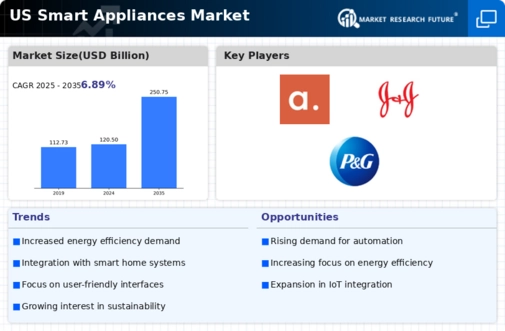The smart appliances market in the US is characterized by a dynamic competitive landscape, driven by technological advancements and evolving consumer preferences. Major players such as Samsung Electronics (KR), LG Electronics (KR), and Whirlpool Corporation (US) are at the forefront, each adopting distinct strategies to enhance their market positioning. Samsung Electronics (KR) emphasizes innovation through its SmartThings platform, which integrates various home devices, thereby fostering a seamless user experience. Meanwhile, LG Electronics (KR) focuses on sustainability, launching energy-efficient appliances that appeal to environmentally conscious consumers. Whirlpool Corporation (US) is leveraging digital transformation, enhancing its product offerings with smart features that cater to the growing demand for connected home solutions. Collectively, these strategies contribute to a competitive environment that prioritizes technological integration and consumer-centric solutions.
Key business tactics within the smart appliances market include localizing manufacturing and optimizing supply chains to enhance efficiency and reduce costs. The market structure appears moderately fragmented, with several key players exerting influence over various segments. This fragmentation allows for niche players to emerge, while larger corporations maintain significant market shares through strategic partnerships and innovation. The collective influence of these key players shapes the competitive dynamics, as they continuously adapt to market demands and technological advancements.
In October 2025, Samsung Electronics (KR) announced a partnership with a leading AI firm to enhance its smart appliance capabilities. This collaboration aims to integrate advanced AI algorithms into their product line, enabling predictive maintenance and personalized user experiences. The strategic importance of this move lies in Samsung's commitment to staying ahead in the rapidly evolving smart home ecosystem, potentially increasing customer loyalty and market share.
In September 2025, LG Electronics (KR) unveiled its new line of smart refrigerators featuring advanced food management systems. This innovation allows users to track food inventory and receive recipe suggestions based on available ingredients. The strategic significance of this launch is twofold: it not only addresses consumer demands for convenience but also positions LG as a leader in integrating smart technology into everyday appliances, thereby enhancing its competitive edge.
In August 2025, Whirlpool Corporation (US) expanded its smart appliance portfolio by introducing a new line of connected washing machines that utilize IoT technology for remote monitoring and control. This strategic action reflects Whirlpool's focus on digital transformation, catering to the increasing consumer preference for smart home solutions. By enhancing user convenience and operational efficiency, Whirlpool aims to solidify its market position amidst growing competition.
As of November 2025, current trends in the smart appliances market include a pronounced emphasis on digitalization, sustainability, and AI integration. Strategic alliances are increasingly shaping the competitive landscape, as companies seek to leverage complementary strengths to enhance their offerings. Looking ahead, competitive differentiation is likely to evolve, shifting from price-based competition to a focus on innovation, technology, and supply chain reliability. This transition underscores the importance of adaptability and forward-thinking strategies in maintaining a competitive advantage in the smart appliances market.













Leave a Comment